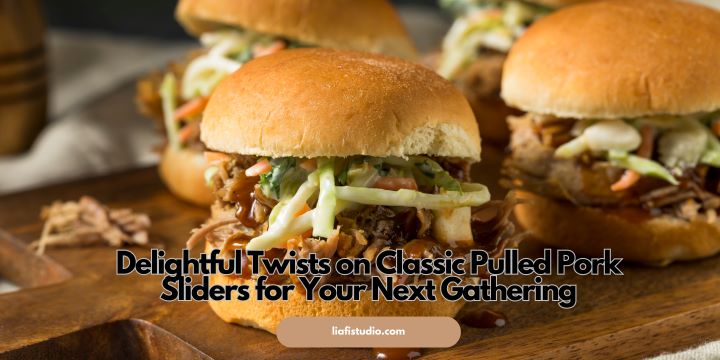Key Takeaways:
- Discover innovative variations to the beloved pulled pork sliders.
- Learn how to pair flavors and textures to elevate your sliders.
- Find out how to source quality ingredients for the best results.
Table of Contents:
- Reinventing the Pulled Pork Slider
- Pairing Flavors: A Symphony on a Bun
- The Importance of Quality Ingredients
- Creative Toppings and Sauces
- Cooking Techniques That Make a Difference
- Party Presentation: Serving Sliders with Style
- Food Safety Tips for Serving Pulled Pork
Reinventing the Pulled Pork Slider
The quintessential pulled pork slider is often the highlight of a casual feast, ubiquitous at backyard barbecues and family picnics. It’s a melding of savory, shredded pork nestled in a soft bun, a bite-sized portion of comfort food that unanimously pleases the crowd. Nonetheless, even the most beloved dish can benefit from a little inventive spark. Culinary adventurers can inject a bit of exotica, replacing traditional barbecue sauce with a zesty pomegranate glaze or adding a spoonful of spicy Korean gochujang to stir up the heat. For those seeking a health-conscious alternative, lean cuts of meat can be utilized, or one can even opt for a plant-based variant, such as jackfruit, which mimics the texture of pork when cooked. By reimagining a well-loved pulled pork sliders recipe, chefs and home cooks alike can write a new chapter in casual dining, surprising and delighting guests with each innovative concoction that challenges their palates and expands their culinary horizons.
Pairing Flavors: A Symphony on a Bun
The artistry in deploying flavors concocts an enchanting narrative for the palate, and the canvas of the pulled pork slider is particularly indulgent. Juxtaposing the tenderness of the pork with a bright, vibrant pineapple salsa adds layers of texture and a pop of color, offering a tropical counterpoint that sings of summer. For those with a penchant for heat, infusing the meat with a piquant blend of chili peppers and ground spices can lend a smoldering zest. At the same time, a garnish of sharp pickled onions cuts through the richness with its astringent bite. Clever utilization of spice and flavor is akin to painting with broad strokes of vibrant color. Each decision enhances the overall composition, all while ensuring that no single flavor overshadows another. Crafting such flavor profiles encourages diners to explore the culinary landscape bite by delicious bite, taking them on a gastronomic journey that is as exciting as it is satisfying.
The Importance of Quality Ingredients
No masterpiece was ever created from mediocre materials. The adage holds especially true in culinary creation, where the freshness and quality of ingredients directly translate to the depth and authenticity of flavors on the plate. Choosing a superior pork shoulder that has been ethically raised and possesses the ideal fat marbling can elevate the simple act of eating a slider into a more luxurious experience. Accompaniments, too, deserve the same discernment; organically grown lettuce, heirloom tomatoes, and homemade pickles can turn a mere sandwich into a celebration of agricultural bounty. These locally sourced, high-quality elements provide a robust foundation for your sliders and reflect an overall ethos of respect—for your guests, the environment, and the food itself.
Creative Toppings and Sauces
The realm of toppings and sauces is where the chef’s creativity is free to soar, transforming the familiar into the exceptional. Picture a homemade relish that bursts with the bright essence of freshly harvested dill or a luxurious spread crafted from crushed macadamia and softly roasted garlic. A zesty sauce that combines dates’ natural sweetness with balsamic vinegar’s tartness can become a topic of conversation as much as the dish it adorns. Extending beyond prepackaged products and dedicating time to the alchemy of sauce-making, you invite an element of craftsmanship and originality into the meal. This commitment to personalization makes the difference between simply feeding your guests and offering them a dining experience woven with intention and care.
Cooking Techniques That Make a Difference
A well-prepared pulled pork is tender, juicy, and well-seasoned—qualities that can only be achieved through a thoughtful cooking process. Low-and-slow roasting allows collagen in the pork shoulder to break down gently, resulting in a texture that’s easy to pull apart yet retains succulent juiciness. For those aiming for a smoky nuance, employing a smoker affords the meat a depth of flavor that is robust and aromatic. Moreover, the sous-vide technique is gaining popularity among culinary enthusiasts for its ability to lock in flavors and juices, ensuring that each pork piece is cooked perfectly with unparalleled tenderness. The final sear or grill marks add that quintessential char and crispness that will leave your guests coveting the recipe—and perhaps even your cooking secrets.
Party Presentation: Serving Sliders with Style
The revelatory instant when dishes are unveiled to guests is laden with expectation and potential. To truly dazzle your audience, a thoughtfully curated presentation should meld with the delectable offerings on display. Utilizing elements like miniature cast iron skillets or slate boards contributes a touch of sophistication. At the same time, a spread of sliders on a bed of vibrant greens provides a feast for the eyes. Choosing the adornments with care—perhaps a sprinkle of edible flowers or an artful swish of sauce—adds a polished touch that speaks to the handcrafted nature of your meal. By curating each aspect, from plate to palate, the once-humble slider is exalted to a main-stage delight, as visually captivating as gastronomically gratifying.
Food Safety Tips for Serving Pulled Pork
Meticulous preparation and artful presentation are key components of the dining experience, yet food safety remains paramount. Proper storage, handling, and cooking techniques are the safeguards against potential health hazards, ensuring that the feast ahead is not only a delectable culinary tour de force but also a responsible one. Keeping the pork at a safe temperature and maintaining a scrupulously clean preparation environment are fundamentals, as follows the USDA’s recommendation to cook pork to an internal temperature of at least 145°F, with a 3-minute rest time after cooking. By diligently adhering to the principles set forth by FoodSafety.gov, you ensure carefree indulgence. With these measures in place, hosts can confidently serve their pulled pork sliders, secure in the knowledge that their guests will remember the occasion for the joy it brought to their taste buds and not the distress it might bring to their well-being.
Applying the aforementioned culinary suggestions can transform a simple slider into a gourmet sensation that anchors your next social event while maintaining a spirit of creativity and adventure. These delightful twists on the classic pulled pork sliders will surprise and impress your guests, leaving them excited for your next gathering. By focusing on excellent ingredients, innovative combinations, meticulous cooking techniques, and sumptuous presentation, each bite delivers a profound experience of flavor and enjoyment—a lasting tribute to culinary artistry and hospitality.







